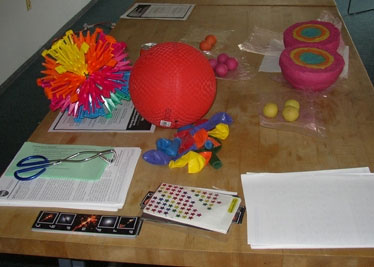Supernova Explosions
Adapted from Chandra X-Ray Center EPO Activities.
- Full Activity (PDF)
- YouTube video of the Supernova Can Crunch Demo
- YouTube video of an similar Supernova Ball Bounce activity, using a tennis ball and a ping pong ball, which makes it better suited to an indoor environment
Summary:
Students are reminded that the Universe is made up of elements and that the heavier elements are created inside of a star as they learned in the "Elements and You" activity. They are introduced to the life cycle of a star and to the way in which a star's mass affects its process of fusion and eventual death. Students discuss the physical concept of equilibrium as a balancing of forces and observe an experiment to demonstrate what happens to a soda can when the interior and exterior forces are not in equilibrium. An analogy is made between this experiment and core collapse in stars, to show the importance of maintaining equilibrium in stars. Finally, students participate in an activity which demonstrates how mass is ejected from a collapsed star in a supernova explosion, thereby dispersing heavier elements throughout the Universe.
Audience:
A group of 20-25 students (grade range 5th-8th)
Objectives:
- Introduce the life cycle of a star
- Discuss the forces at work inside a star
- Understand the role of mass in determining the extent of fusion and the fate of a star
- Learn about core collapse of a star
- Simulate mass ejection and understand how to populate the universe with the heavy elements from the interior of stars during a supernova explosion
Materials:
- Colored balloons (1 of each of the following colors: red, orange, yellow, green, blue, and violet)
- Empty aluminum soda cans
- Hot plate (or Bunsen burner and screen/ring setup)
- Large, deep bowl of ice water
- Tongs or oven mitts
- Hoberman sphere
- Basketballs (or kickballs, soccer balls, etc)
- Tennis balls
Preparation:
- Make sure you have ice made up ahead of time. Although this activity can work without ice as long as you have very cold water, it is easier with ice water.
- It is a good idea to practice the imploding can trick (ideally with the same tools you will have during the session) before you are called upon to perform in front of students. Make sure that you can see plenty of steam from the can and can hear it bubbling before inverting it onto the water. This can be a temperamental demonstration, and practice helps a lot.
- Also, it may take a while for the water in the can to boil, so it's a good idea to start it heating before starting the activity, or have a helper set it up ~15 minutes before you get to that part of the activity. (Actual heating times will vary depending on your hotplate.)




